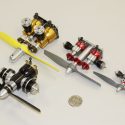
.040 Opposed 2-Cylinder, 2-Cycle Aero Engine
Craftsman: Array
Knapp Collection #: Array
Catalog #: Array
Array: Array
John Swartzwelder fabricated several small multi-cylinder aircraft engines from commercially available Cox .049, .020, and .010 cc model airplane engines.

.098 Opposed 2-Cylinder, 2-Cycle Aero Engine
Craftsman: Array
Knapp Collection #: Array
Catalog #: Array
Array: Array
John Swartzwelder fabricated several small multi-cylinder aircraft engines from commercially available Cox .049, .020, and .010 cc model airplane engines.

.098 Vertical 2-Cylinder, 2-Cycle Aero Engine
Craftsman: Array
Knapp Collection #: Array
Catalog #: Array
Array: Array
John Swartzwelder fabricated several small multi-cylinder aircraft engines from commercially available Cox .049, .020, and .010 cc model airplane engines.

